リスク対応策 2021.08.06
RM 64 タイタニック号が示唆する、キャプティブ The Titanic suggests, Captive
For those who prefer to read this column in English, the Japanese text is followed by a British English translation, so please scroll down to the bottom of the Japanese text.
2004年6月に撮影された海底に沈んでいるタイタニック号の船首部分。
The bow section of the Titanic as it sinks to the seabed, photographed in June 2004.
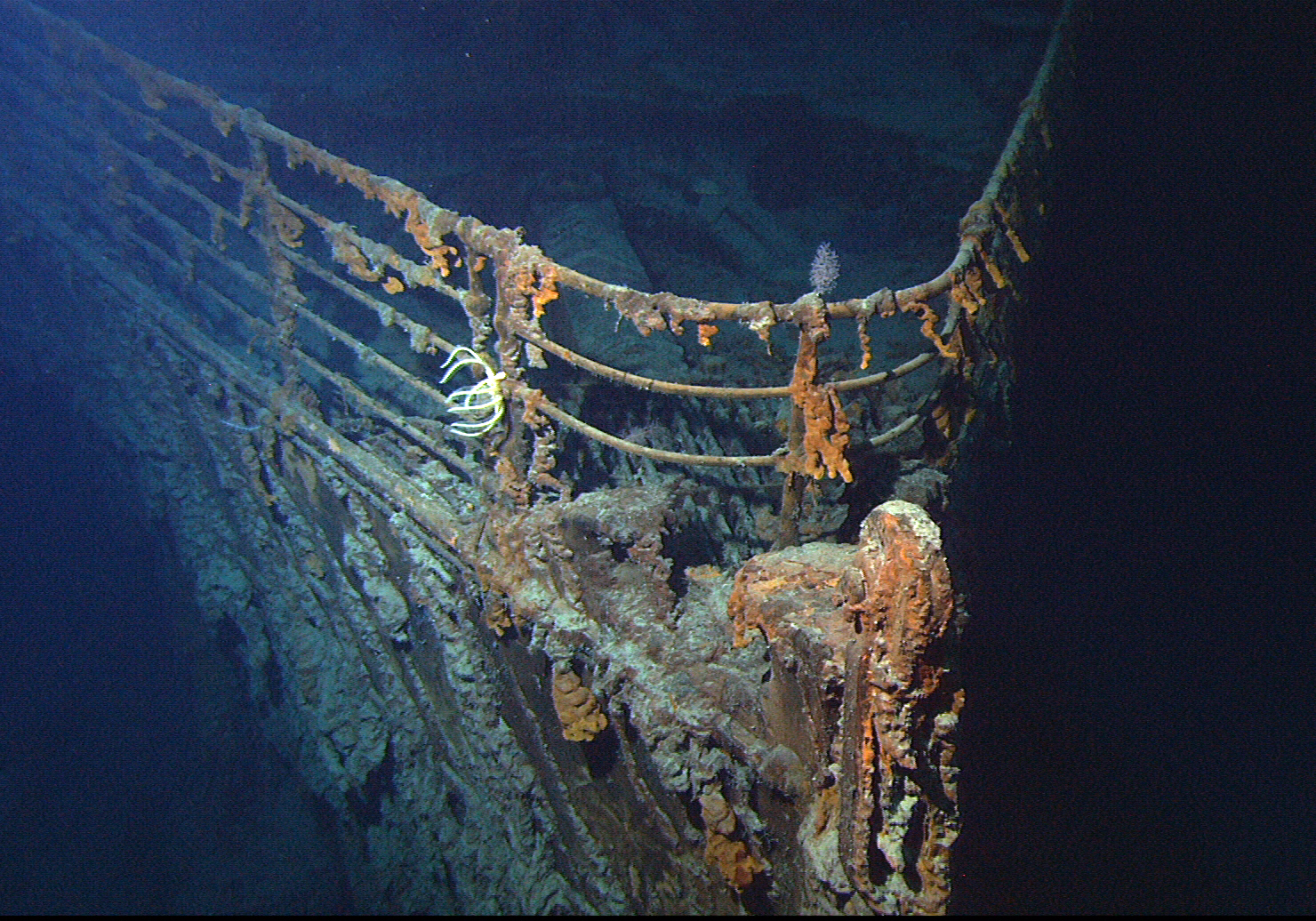
昨年、2020年10月24日本コラムに投稿した「CS14 - ロイズ発展の理由 Reasons for the development of Lloyd’s of London」のなかに、英国の悲劇の旅客船「タイタニック号」ついて、以下の一文を記した。
映画にもなった伝説の旅客船「タイタニック号」は、郵便船でもあった。「ロイヤル・メール」と契約しており、正式名称は「RMS(Royal Mail Ship)Titanic」である。1912年、氷山に衝突したあの日には3000通もの郵便物を乗せていた。その郵便保管室のスタッフは、浸水してきたことに気づくと上方のデッキへ郵便物を移動させたと言われている。10数年ほど前、ロンドンに出張した際に見学した、「ロンドン科学博物館」で開催されていた「タイタニック展」では、海中から引き揚げられた船体の一部とともに、当時の客室乗務員がその光景を振り返った言葉も展示されていた。
「10数年ほど前」と記した「タイタニック展」、正確には2003年5月、英国ロンドン、ハイドパーク近くのサウス・ケンジントンの「科学博物館」で、通称「タイタニック号」、正式名称「RMS Titanic(ロイヤルメールシップ・タイタニック)」からの引上品展が開催されていた。定宿のランカスター・ゲートのホテルから歩いてハイドパーク、ケンジントン・ガーデンを横切り、ロイヤル・アルバート・ホールを過ぎるとすぐ、米国の鉄鋼王アンドリュー・カーネギーから寄贈された「大型草食性恐竜『ディプロドクス』の全身の複製骨格」で有名な「自然史博物館」の威厳のある建物が目に入ってくる。
その隣にある同様の建物が「ロンドン科学博物館(サイエンス・ミュージアム)」である。産業革命を勃興させたジェームズ・ワットの蒸気機関の実物が動態保存の状態で展示されている場所でもある。
タイタニック号の航海当時の「ロイヤル・メール」とは、その名のとおり英国の郵政省の一部であったが、現在では民営化され一企業として存在している。
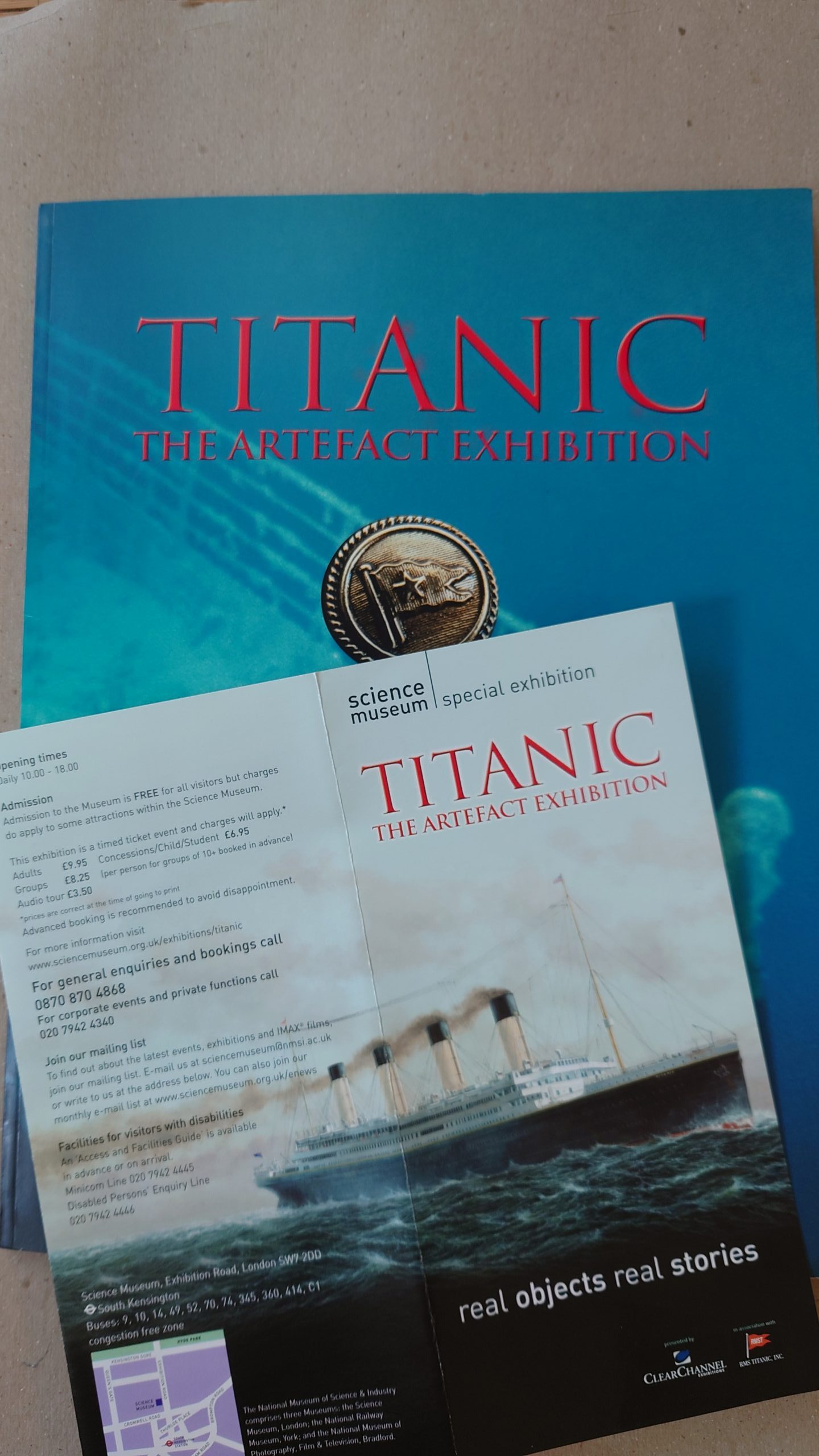
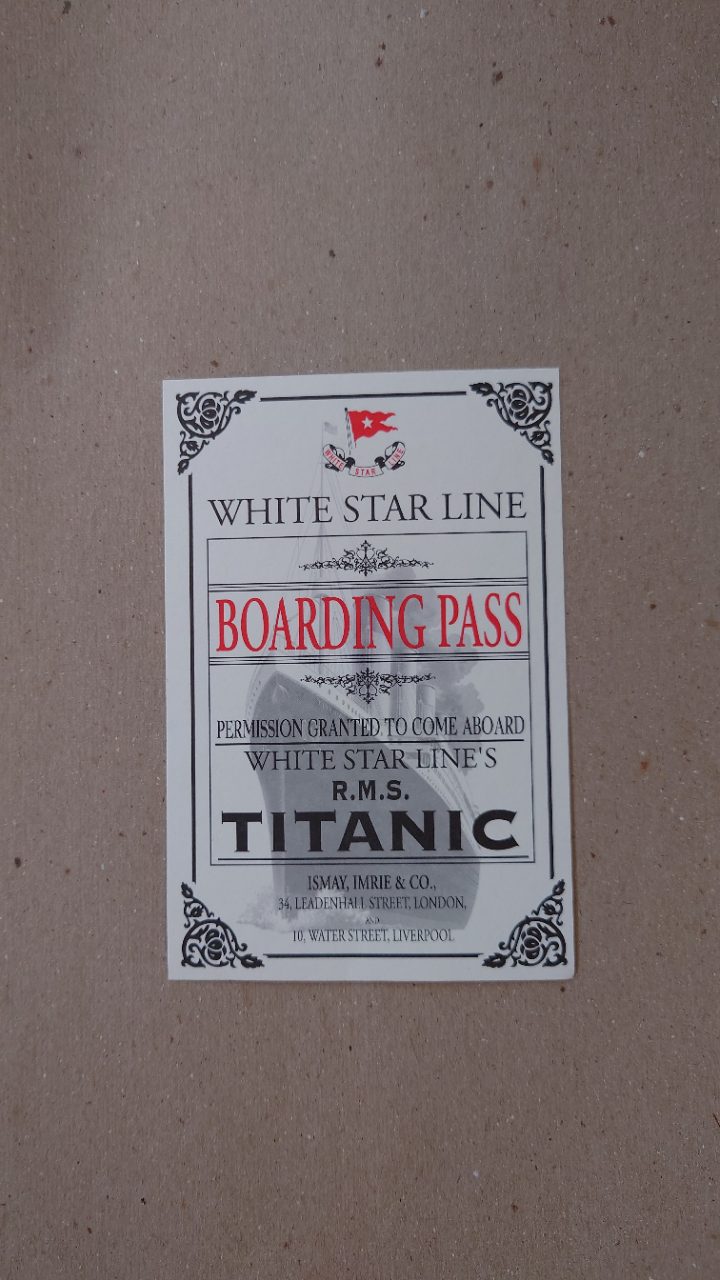
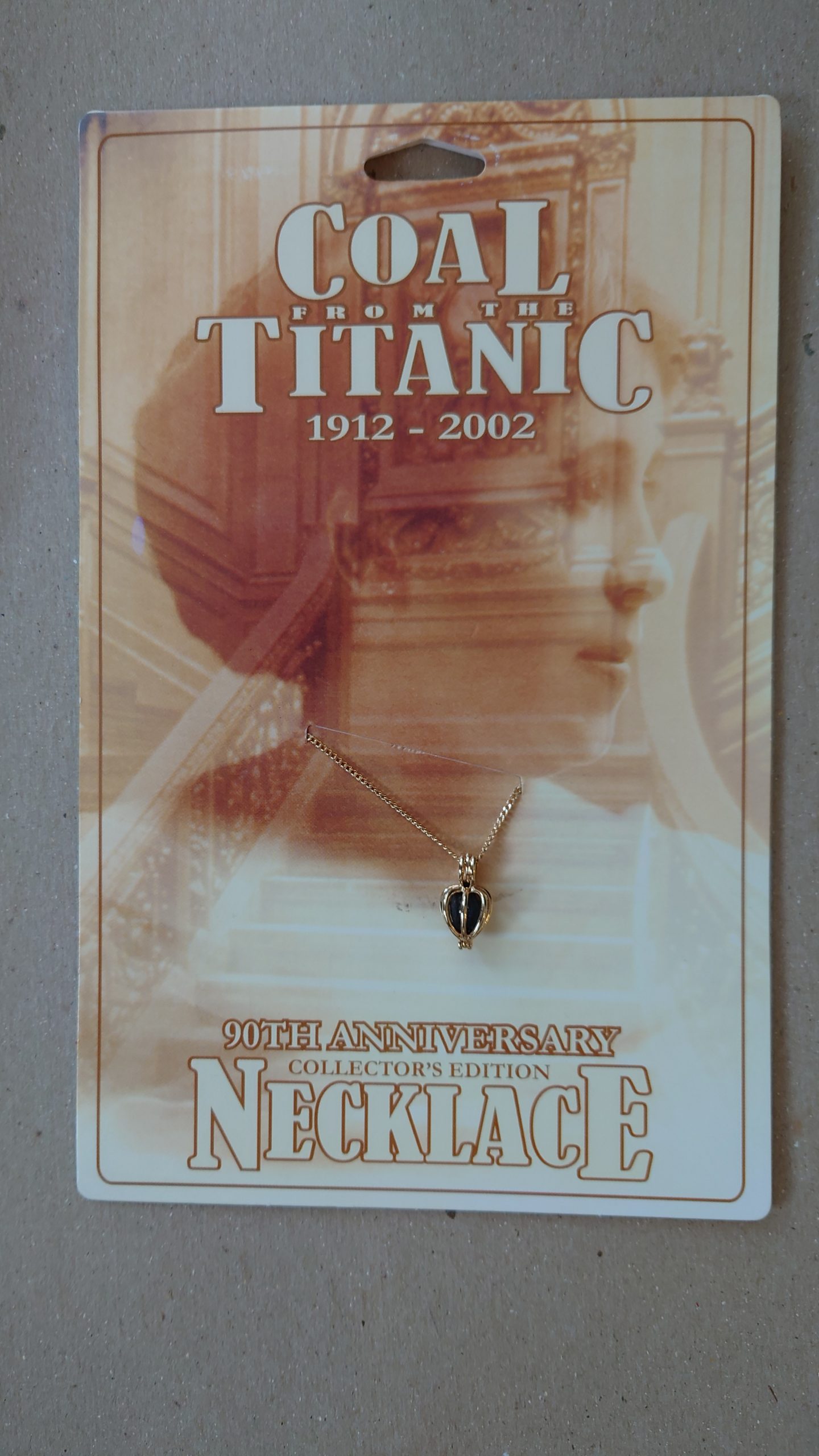
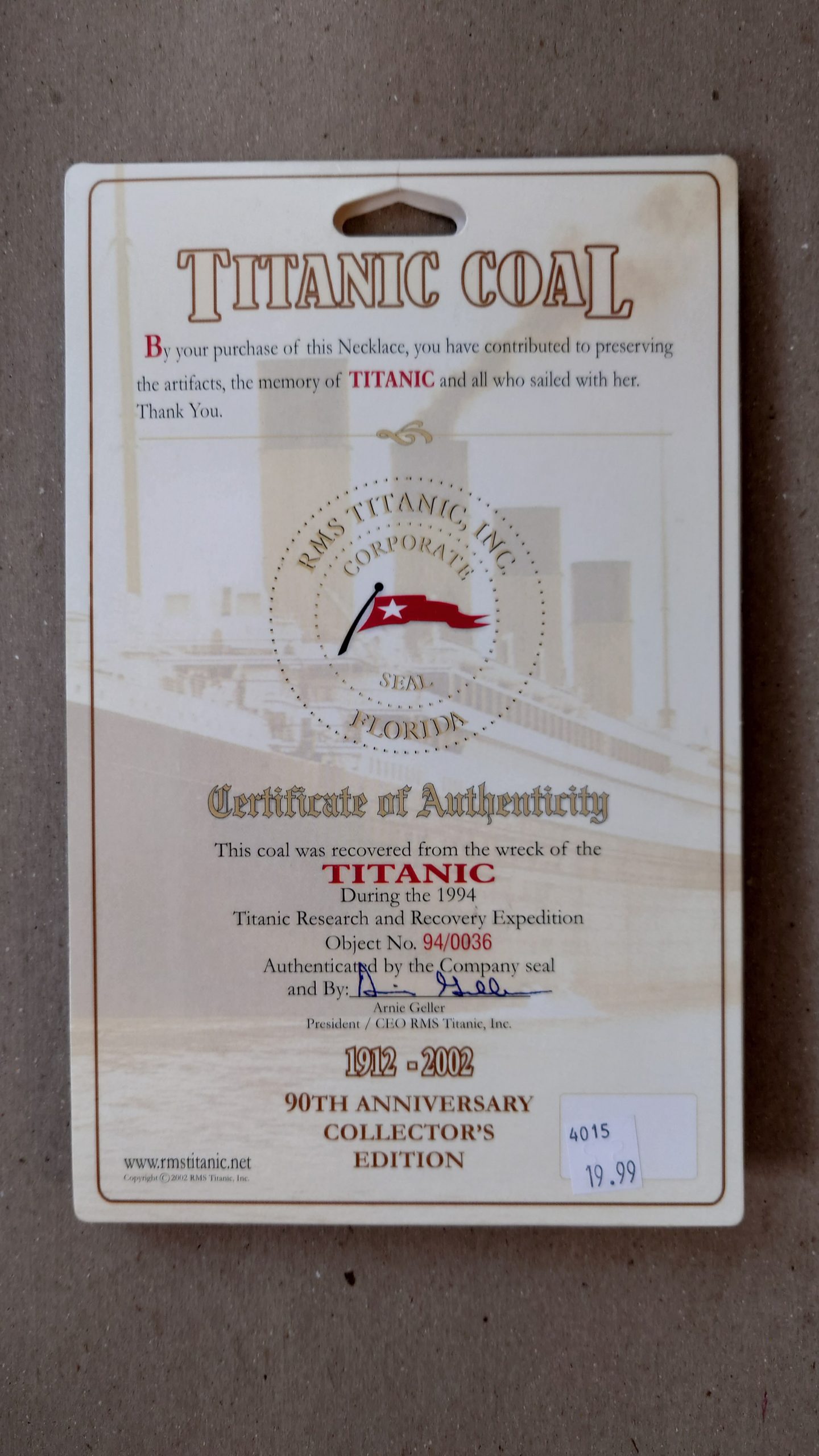
「タイタニック展」で購入したパンフレット他記念品の数々
Brochures and other memorabilia purchased at” the Titanic exhibition”
1.タイタニック号
タイタニック号は、英国の海運会社「ホワイト・スター・ライン社」が北大西洋航路用に姉妹船2隻(オリンピック号、ブリタニック号)と同時期に「2番船」として建造したが、様々理由によって竣工したのは最後となった船である。この姉妹船3隻は最初に竣工した「オリンピック号」の名前から「オリンピック級客船」と呼ばれているが、3隻のうちタイタニック号だけの名前が広く知られているのは、処女航海中、1912年4月14日深夜から翌日15日未明にかけて、北大西洋上で氷山に接触、沈没、乗員・乗客合わせて1,500人以上の犠牲者を出し、20世紀最大の海難事故となったからである。
新天地米国を目指して多くの人々がヨーロッパから渡って行った19世紀は、「移民の世紀」とも言われるほど「大西洋航路」は賑わった。宗教的迫害、貧困、政治信条の違い等、数々の問題を抱えていたヨーロッパの人々にとって米国は「希望の新天地」であった。自らも高額の報酬でニューヨークの音楽院院長にと招聘された、チェコを代表する作曲家アントニン・ドヴォルザークが1893年5月に完成した交響曲第9番「新世界より」にその当時の人々が米国に対して抱いていた、希望と憧れがよく描かれている。
当時ヨーロッパから米国へは、英国、ドイツから、それぞれ毎年10万人を超える移民が渡航した。そうした彼らに続くように、ロシア、他のヨーロッパ諸国からも多くの移民が大西洋を渡っていった。「飛行機の無い時代」であり、その渡航手段は旅客船であった。この膨大な需要を満たすために、大型旅客船の需要が高まっていった。各国の海運会社は旅客船の建造に続々と乗り出し、船の高速化と大型化競争が随所で起きていた。蒸気船による最初の大西洋横断は1833年であったが、「需要増」が後押しした「高速化」の流れは大きくなった。更に、「大西洋横断最速記録」の宣伝を目的とする、「最速船」の栄誉を与える「ブルーリボン賞」という表彰制度ができてから、その流れが一機に加速されていった。
ホワイトスター・ライン社の社長であったトーマス・イズメイは、大型客船に、「スピード、大きさ、豪華さ、これらすべてを求めるのは経済的ではない」と判断して、「豪華さ」にのみ焦点を当てた旅客船を建造して、一代で同社を大企業へと押し上げた。彼の没後、会社を引き継いだのは、タイタニック号を建造した息子のブルース・イズメイであった。
「大英帝国」として世界に多くの植民地を有し世界の覇権を握っていた当時の英国には、幾つかの巨大な海運会社があったが、なかでも「タイタニック号」の建造計画が進んでいた頃、ホワイト・スター・ライン社の最大の競争相手は、現在でも「クイーンメリー2号」という巨大な旅客船を有し大きなビジネスを展開しているキュナード・ライン社という海運会社であった。このキュナード・ライン社は、高速航行が可能な2隻の豪華客船を運行していた。これに対抗するには、これを更に上回る「3隻の姉妹船が必要だ」と考えて、1908年12月にまず第1号の「オリンピック号」、続いて数ヵ月後には「タイタニック号」、そしてオリンピック号の進水式が終わるとすぐに、3隻目の「ブリタニック号」を起工した。
タイタニック号の処女航海は1912年2月に予定されていたが、先に運行を開始していた「オリンピック号」が接触事故を起こしてドック入りしたためタイタニック号建造が一時中断され、1ヶ月遅れで3月に完成、4月10日が処女航海の出航日と決まった。
2.リスク
タイタニック号が1912年4月15日未明、氷山と衝突して沈没、乗船していた2,000名以上の乗客のうち1,500名を超える犠牲者を出した事故には、当然「事故に至る結果を生んだ幾つかのリスクが存在」していた。
① 第1のリスク:出港時期のずれ
日本で4月といえば、多くの場所で「桜の咲く頃」、おおよそ北緯35度の東京では暖かい気候から既に初夏を思わせる天候に変化していく頃でもある。しかし、出発港の英国、ロンドン南方のサウサンプトンの緯度は、北緯43度の北海道の北、シベリアのイルクーツクと同程度の緯度、北緯50度であり、英国から米国までの北大西洋航路は北緯50度を超えている航路である。そんな厳寒の地にも、4月には海流に乗って南下してくる氷山群が米国ニューファンドランド沖に現れる、航海にとっては非常に大きな「障害物=リスク」が顕われてくる時期でもある。
② 第2のリスク:船の設計上の問題
タイタニック号は、100年以上経った現在でも「巨大な客船」と考えられるが、当時としては想像を絶する大きさであったと言えよう。全長269メートル、幅28・2メートル、総トン数46,329トン。対抗するキュナード・ライン社の船と比較しても、群を抜いた大きさであった。しかも、万が一浸水が起こっても15の防水隔壁があり、船底は16の区画に仕切られていて、「安全性も十分」と宣伝され、人々もそう考えていた。当時、船の衝突が起きても2区画以上が壊れることは「あり得ないこと」とされていたが、「4区画が浸水しても浮かんでいる」ように設計されていたからであり、「不沈船」とさえ呼ばれた。
しかし、「豪華さ」に焦点を当てることが優先されたため、「海を見るための広い遊歩デッキが計画されたタイタニック号のデッキに、多くの救命ボートを置くと視界の妨げになる」とイズメイ社長の命令が下り、後の「悲劇」の序章を奏でるリスクが発生することになった。万が一の避難の際に必要な救命ボートは、20艘だった。1艘あたり通常40名、最大で60名乗れたとしても、タイタニック号の最大定員3,300名の3分の1、1,200名程度であり、「3分の2の乗員、乗客には、助かる手段は無かった」のである。
ただ、不思議なことにこれは「違法」ではなかった。当時の英国の法律では、1万トン以上の船の救命ボートの数は「最低16艘」と定められていたからである。理由は、救命ボートは外洋を避難していくためのものではなく、近くに「来るであろう」救助船への移動手段として定義されていたためである。船が航行できないような損傷、故障が船に起きても、「巨大な客船がすぐさま沈没する」とは考えられておらず、「救助船が到着するまで、1日もしくは2日間程度の時間は少なくとも十分浮いている」と考えられていた。まして「不沈船」である、まさか「2時間程度で沈没する」とは「想定外」で、誰もそう考えていなかったのである。
③ 第3のリスク:出港前の火事の船体への影響
2017年1月、英国の新聞(インディペンデント紙)、テレビ番組(チャンネル4)でも報道されたが、出港前、タイタニック号の石炭倉庫内で火事が起きていた。石炭は自然発火しやすく、また発火後はなかなか消火できない特性を持っている。日頃は「石炭の発火リスク」にも気を配りながら積載するが、処女航海で慌ただしく準備したためその配慮がなされることがなかったからであろう、積まれた石炭によって自然発火が起きた。テレビ番組で紹介されたタイタニック号の出港前の写真には、船首付近の「後に氷山と衝突して裂け目が出来た箇所」に「黒ずみ」があったのがその証拠と報じていた。建造計画が1ヶ月遅れて「これ以上の遅延は許されない」という状況にあったため、タイタニック号は、事故とその船体への影響を十分検証をすることなく出港せざるを得なかったのである。「チャンネル4」では「石炭が燻りながら航行していた」という証言も紹介されていた。
また、当時船舶を建造した「鉄」は、現代のものより質が劣り、熱が加わると更に劣化する傾向があった。一旦熱が加えられ劣化した箇所が厳寒の北大西洋航路で冷やされることで、「氷山との衝突の衝撃が船体に与えた力は何倍にも増幅された可能性」があるのである。
④ 第4のリスク:氷山出現リスクへの緊迫感の欠如
タイタニック号の通信手は、他の船舶から氷山に関する6件の警告通信を受け取っていたが、全てを船長に報告したわけではなかった。
現代であれば、通信手は当然「船の乗員の一員」として、すべて船長に報告する、またその義務がある。しかし、当時の通信手の立場は現代と異なっていた。1896年イタリアのグリエルモ・マルコーニが無線の実用化に成功して、無線設備は1898年には英国王室用のヨットに設置され、それ以降急速に発展、「外洋航路の船には、どの船にも完備されていた」状態であったが、タイタニック号出港の頃、船に装備されていた無線設備は海運会社所有ではなく、「無線会社の所有物」であり、通信手も海運会社の社員、船の乗員ではなく、無線会社の社員であったのである。
そのため、彼らは、乗船客の電報サービス業務を主たる業として乗船しており、気象情報について受信した無線報告情報を船長に報告するか否かは、あくまでも通信手の判断に任されていたのである。
⑤ 第5のリスク:双眼鏡の欠如
「ブルーリボン賞」の獲得競争をおこなっていたタイタニック号は、速度を落とさず氷山が多数流れている海域に入っていったが、現代のようにレーダーがあるわけでは無く、「周りとの衝突リスク」を事前に知る手段は、「デッキから30メートル近いマストに登って見張り台で見張りをおこなう監視員の視力頼み」であった。しかし、タイタニック号の監視員の手には、見張りに重要な双眼鏡が無かった。双眼鏡の保管庫の鍵を持った船員が鍵を持ったまま会社への不満から下船、「定時航行原則」からタイタニック号は、そのまま出航したため、「本来はあるべき見張り用の双眼鏡を監視員は手にすることが出来なかった」のである。氷山が接近してくるまでそのリスクを認識できず回避できなかった理由の一つがここにある。
⑥ 第6のリスク:高速航行の継続
北大西洋航路を航行するのであるから、当然乗員は近くに氷山が存在するリスクがあることは知っていたが、定時航行、あわよくば「ブルーリボン賞」とかなりの高速で航行していた。しかも、世界が注目しているタイタニック号の処女航海である。減速航行をしていれば避けられたであろう「氷山との衝突」、これを避けることが出来なかった最大の理由がここにある。現代の「自動車事故」でも同じことがよく言われる。
冒頭記した、タイタニック号より約1年前に就航した姉妹船オリンピック号の「衝突事故」とは、タイタニック号出航2か月前、オリンピック号が軍艦に激突され船体に致命的な損傷を受けた事故のことである。しかし、海事裁判では、「この事故の責任はオリンピック号にある」との判決が出て、巨額な投資をして建造したオリンピック号にさらに再度の投資が必要になり、このためホワイト・スター・ライン社は倒産寸前の状態に陥り、この経営難のため「会社売却」の羽目になったのである。
買収された親会社からは、「早急に利益を出すこと」を厳命されていたこともあり、建造費用を抑えるためにタイタニック号の救命ボートの数も「設計の半分」にしたのである。タイタニック号は、何としても早く出航して利益をあげる途しか残されていなかった。「氷山出現の警告」を受けても大きく航路を変えて回避しなかったのは、経営難のためニューヨークに辿り着く分の石炭しか積んでいなかったこともその理由の一つである。
ただ、そんな状況など微塵も出さず、ホワイトスター・ライン社の社長イズメイは、華麗な船内、デッキを楽しみ、贅を尽くした料理に舌鼓を打つタイタニック号の最初の「一等船客」の一人として乗船していた。しかし、航海士たちは毎日正午には1日で進んだ距離を計測して、「距離や速度」を公表した。このスピードで賭けに興じる乗客達も多くいた、それほどタイタニック号の速度は速く、「新記録樹立」も目前であったのである。
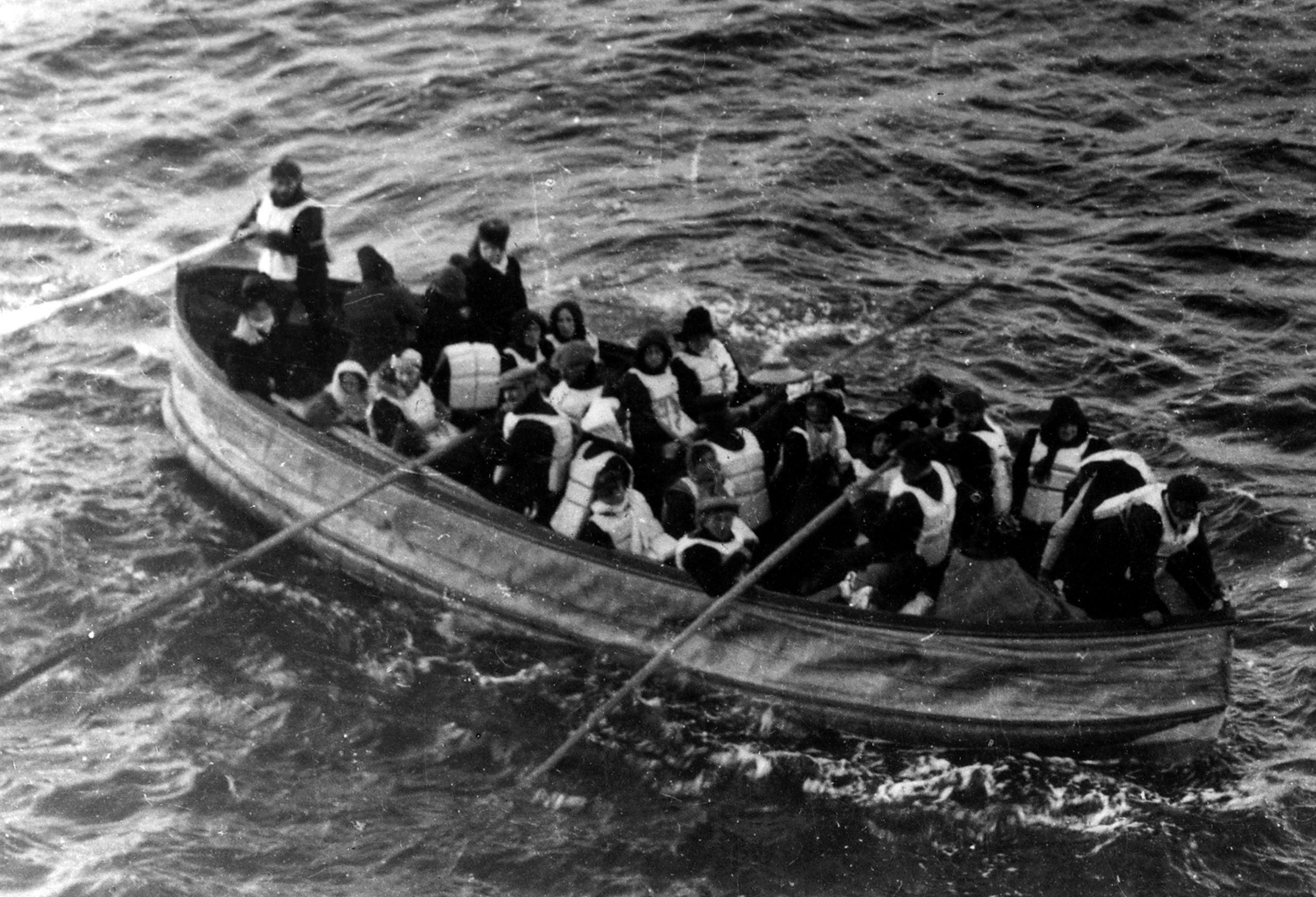
1912年4月15日朝、カルパチア号から撮影された折りたたみボートD
Folding boat D, taken from the Carpathian (RMS Carpathian)、on the morning of 15 April 1912

「タイタニック展」で購入した「ニューヨーク・トリビューン新聞(1912年4月15日付:全14ページ)」の復刻版
” A reprint of the New York Tribune (15 April 1912, 14 pages)”, purchased at the Titanic exhibition
3.救助
救命ボートに運良く乗れたタイタニック号の約700名の生存者達は、沈没から数時間経って、ホワイトスター・ライン社の競争相手、キュナード・ライン社の「カルパチア号」によって救助されたが、冷水に浸かった後遺症でその後多くの人達が苦しみ、事故後まもなく早世した人達も多かったと記録されている。
今回のまとめ
タイタニック号の悲劇は、世界を駆け巡った。多くの乗客、乗組員が犠牲になるなか、タイタニック号の所有者である会社の社長、イズメイが生き残ったということに対しては、非難の声が巻き起こった。更に、英国に帰国した彼を待っていたのは、「査問委員会」からの厳しい指摘と世論からの激しい非難であった。やがてホワイトスター・ライン社を辞め、事故後25年後、失意のうち74歳でその悔恨の生涯を閉じた。
「リスクマネジメント」の視点からこの「タイタニック号の悲劇」を検証していくと前述の通り、「本来は減じることができた、また消去することさえできたリスク」が明らかになっている。
タイタニック号が沈没した原因は、「氷山に衝突して船体右側の船首付近から中央部分にかけて大きな亀裂が生じて海水が浸入した」と長い間考えられてきたが、近年の調査では、「氷山は船体を擦っただけであること」が判明した。その「擦ったこと」によって船腹の鉄板がたわんで、鉄板を留めていた「リベットが弾け跳び鉄板の継ぎ目に隙間が生じたのが事故の真相であること」が判明した。しかも、この隙間の大きさは全てを足しても「僅か1平方メートル」程度であったと報告されている。「僅か1メートル四方の広さの隙間」が、「全長269メートル、幅28・2メートル、総トン数46,329トンの巨大な船」を沈没させた主因である。
現代の企業でも「僅か1平方メートル」程度の事業推進上の「リスク」が会社の屋台骨にひびを入れ最悪の場合、事業停止、倒産となるケースも多々ある。キャプティブを視野にした本格的なリスクマネジメントが重要な理由をタイタニック号の悲劇に見る思いである。
このタイタニック号の悲劇を生んだリスクは、全て「想定外」と枕詞を付けながらも当時の人達にとっては「小さなリスク」ばかりと言えよう。しかし、その「小さなリスク」に人為的ミスが重なり、更に人々の思考のバイアスが掛かり重大な事故へと繋がっていったのである。
「タイタニック号の沈没事故」は、英国、米国どちらの調査に於いても、海運会社「ホワイトスター・ライン社」、「乗組員」等による「過失が原因」とは認定されなかった。しかし、この事故を契機として、事故時の対応に関して大きな議論が沸き、それまで各国がそれぞれの国内法により規定していた船舶の安全性確保について、1914年海上における人命の安全のための国際条約(SOLAS)が作られ、船舶への無線装置配備の義務が強化され、無線通信が普及するきっかけとなった。その後、毎年のように改正が施され今も海の安全を守る条約となっている。
氷山という自然の脅威がもたらしたこの大惨事は、当時の人々の「想定を超えた不運」が重なり合った結果だったとも言える。しかし、この「不沈船」と言われた船が「想定外」のスピードであっけなく沈んだように、技術が大きく進歩した現代でも、技術を過信すれば同じことが起きる。同様に、2011年「想定外」と言われた東日本大震災に日本は襲われ、更に昨年2020年から、今度は世界的な規模での「想定外」の災害とも言える「新型コロナウイルスのパンデミック」に未だに日本が、世界が苦しんでいる。
「想定できる=想定内」とは、「それまでの常識がもたらした想定で予期される『仮説』に過ぎない」ということを肝に銘じなければならないのではないだろうか。「想定外」を検証する手段がリスクマネジメントである。「キャプティブ」という「リスクマネジメントの核となる組織体」を構築する本格的なリスクマネジメントをおこなうことが必須であるのではないだろうか。2年前には全く「想定外」だった、新型コロナウイルスの感染拡大のニュースに触れる度に、そう感じている。
マスコミ、人々の関心が、オリンピック、新型コロナに傾いているいま、「思考の想定外」に追いやられて「埋没している氷山」とも言える「南海トラフ大地震」リスクへの確かな備えをすべき時ではないだろうか。
執筆・翻訳者:羽谷 信一郎
English Translation
Risk Management(RM)64 – The Titanic suggests, Captive
Last year, on 24 October 2020, in my article “CS14 – Reasons for the development of Lloyd’s of London”, I wrote the following about Britain’s tragic passenger ship, the Titanic.
The Titanic, the legendary passenger ship that made the movies, was also a mail ship. On the day she hit the iceberg in 1912, she was carrying 3,000 pieces of mail. About ten years ago, on a business trip to London, I visited the Titanic exhibition at the London Science Museum, where I saw parts of the ship pulled out of the water, and a cabin crew member recounting the scene.
“The Titanic exhibition” was held at the Science Museum in South Kensington, near Hyde Park, London, in May 2003, when the Titanic, officially known as the RMS Titanic, was salvaged. I walked from my hotel in Lancaster Gate, across Hyde Park and Kensington Gardens, past the Royal Albert Hall, to the majestic building of the Natural History Museum, famous for the full-length replica skeleton of the large herbivorous dinosaur Diplodocus, donated by the American steel magnate Andrew Carnegie. Next to the majestic building of the Natural History Museum, is the Science Museum, a similar building. This is also where you will find the real James Watt steam engine that started the Industrial Revolution, preserved in working order.
At the time of the Titanic’s voyage, the Royal Mail was, as its name suggests, part of the British postal service, but it is now a privatised company.
1. The Titanic
The Titanic was built by the British shipping company White Star Line as a “second ship” at the same time as her two sister ships (Olympic and Britannic) for the North Atlantic route, but for distinct reasons she was the last ship to be completed. The three sister ships are known as the Olympic class passenger ships because of the name of the first ship, the Olympic, but of the three, only the Titanic is more widely known because it was on its maiden voyage when it hit an iceberg in the North Atlantic Ocean between midnight on 14 April 1912 and early morning on the following day, 15 April, and sank, killing 1,500 passengers and crew, making it the biggest maritime disaster of the 20th century.
The nineteenth century was known as the “century of emigration”, with many people leaving Europe for the new world of the United States. The United States was a “new land of hope” for Europeans who were facing many problems such as religious persecution, poverty, and differences in political beliefs. The Czech composer Antonin Dvořák, who was himself offered a lucrative position as Director of the New York Conservatory of Music, described the hopes and aspirations that people had for the United States in his Symphony No. 9” From the New World”, completed in May 1893.
At that time more than 100,000 immigrants came to the United States from Europe, from England and Germany respectively, every year. They were followed by many others from Russia and other European countries who crossed the Atlantic. It was “the age of no planes” and the only way to travel was by sea. To meet this huge demand, the need for large passenger ships increased. Shipping companies from all over the world began to build increased passenger ships, and the race to build faster and bigger ships was on everywhere. The first crossing of the Atlantic by steamship had been made in 1833, but the trend towards higher speeds, driven by ” increased demand”, was growing. This trend was further accelerated by the creation of the” Blue-Ribbon Award”, which was given to the “fastest ship” to promote the “record for the fastest transatlantic crossing”.
Thomas Ismay, the managing director of the White Star Line, decided that it was not economical to build large passenger ships that were “all about speed, size and luxury”, and built passenger ships that focused solely on “luxury”, turning the company into a major player. After his death, the company was taken over by his son Bruce Ismay, who also built the Titanic.
“The British Empire”, with its many colonies around the world, was the world’s dominant power and there were several large shipping companies. At the time of the Titanic’s construction, White Star Line’s biggest competitor was Cunard Line, a shipping company still doing big business with its huge Queen Mary 2 passenger ship. The Cunard Line operated two luxury passenger ships capable of high speeds. To compete with this, the company decided that it would need three more sister ships, so in December 1908 it commissioned the first, the Olympic, followed a few months later by the Titanic, and as soon as the Olympic had been launched, the third, the Britannic.
The maiden voyage of the Titanic was scheduled for February 1912, but the construction of the Titanic was temporarily halted when the Olympic, which had already been in service, suffered a collision and had to dock.
2. Risk
The Titanic sank in the early hours of 15 April 1912 after colliding with an iceberg, killing over 1,500 of the more than 2,000 passengers on board. Naturally, there were “several risks which resulted in the accident”.
①First risk: the delay in sailing
April in Japan is the time when the cherry blossoms bloom in many places, and in Tokyo, which is roughly at 35 degrees north latitude, the weather is already changing from warm to early summer. However, the latitude of Southampton, south of London in the UK, is about the same as that of Irkutsk in Siberia, north of Hokkaido at 43 degrees north latitude, and the North Atlantic route from the UK to the US is above 50 degrees north latitude. In April, a group of icebergs appear off the coast of Newfoundland in the United States, moving southward on the ocean current.
②Second risk: problems with the ship’s design.
The Titanic is still considered a “huge passenger ship” more than one hundred years later, but at the time it was unimaginably large. It was 269 metres long, 28.2 metres wide and had a gross tonnage of 46,329 tons. Compared to her rival, the Cunard Line, she was an outstandingly large ship. The ship was advertised, and people thought so, as being “safe enough”, with fifteen watertight bulkheads and sixteen compartments in the bottom in case of flooding. At the time, it was considered “impossible” for more than two compartments to be destroyed in the event of a ship collision, because the ship was designed to “stay afloat even if four compartments were flooded”, hence the name “unsinkable”.
However, the focus on “luxury” led to a risk that played a prelude to a later “tragedy” when Mr Ismay ordered that “too many lifeboats on the deck of the Titanic”, which was planned to have a large promenade deck for viewing the sea, would obstruct the view”. The number of lifeboats needed in the event of an evacuation was 20: each boat could normally carry forty people, but even if the maximum number of lifeboats were sixty, that would only be about 1,200, a third of the Titanic’s maximum capacity of 3,300, and “two-thirds of the crew and passengers would have had no means of escape”.
Strangely enough, this was not “illegal”. British law at the time required a minimum of sixteen lifeboats on ships of 10,000 tons or more. The reason for this was that lifeboats were not defined as a means of evacuating the open sea, but as a means of getting to a nearby rescue ship that was” likely to come along”. Even if a ship was damaged or broke down in such a way as to render it unseaworthy, it was not thought that “a huge passenger ship would immediately sink”, but that it would “stay afloat long enough for at least a day or two before a rescue ship arrived”. In addition, as an ” unsinkable ship “, it was not expected that the ship would sink in about 2 hours, and no one thought so.
③ Third risk: the impact of a fire on the ship before departure
In January 2017, as reported in a British newspaper (The Independent) and on TV (Channel 4), a fire broke out in the Titanic’s coal warehouse before she left port. Coal is prone to spontaneous combustion and is notoriously difficult to extinguish once ignited. Normally, the risk of coal ignition is considered when loading coal, but the hasty preparations for the maiden voyage meant that this was not considered when the coal was loaded. A television programme showed a photograph of the Titanic before she sailed, showing evidence of this by the “blackening” of the bow, “where a crack had been formed by a later collision with an iceberg”. With a month’s delay in the building programme and “no further delays allowed”, the Titanic was forced to leave the port without fully examining the accident and its effects on the ship. “Channel 4” reported that the ship was “sailing on smouldering coal”.
The iron with which ships were built in those days was of inferior quality to modern steel and tended to deteriorate further when heated. The impact of the iceberg collision on the hull of the ship could have been amplified many times over”.
④Fourth risk: Lack of urgency about the risk of icebergs
The Titanic’s operator had received six warning messages about icebergs from other ships, but he did not report all of them to the captain.
In modern times, as a “member of the ship’s crew”, he would naturally have reported everything to the captain, and would have been obliged to do so. In 1896, Guglielmo Marconi of Italy succeeded in making wireless practical, and in 1898, wireless equipment was installed on the Royal Yacht, and since then it has developed rapidly, so that “every ocean-going ship is equipped with it”. At the time of the Titanic’s departure, the wireless equipment on board was not owned by the shipping company, but by the wireless company, and the communicators were not employees of the shipping company or the crew of the ship, but employees of the wireless company.
Therefore, their core business was to provide telegraphic services to passengers on board the ship, and it was up to them to decide whether to report to the master the radio reports they received on weather information.
⑤Fifth risk: lack of binoculars
In the race for the “Blue Ribbon”, the Titanic entered the iceberg-filled waters without slowing down, but without the radar of today, the only way to know in advance the “risk of collision” was to rely on the eyesight of the watchman, who was on a lookout post on a nearly 30 metres up the mast from the deck. However, the Titanic’s watchkeepers did not have binoculars in their hands, which were crucial for the watch. The crew member who had the key to the binocular vault disembarked from the ship because he was dissatisfied with the company, and the Titanic sailed on “the principle of regular sailing”, so “the watchman did not have access to the binoculars he was supposed to have”. This is one of the reasons why the risk could not be recognised and avoided until the iceberg was approaching.
As the ship was sailing through the North Atlantic, the crew knew that there was a risk of icebergs being nearby, but they were sailing at a high speed to keep the ship on time, or even to win a “blue ribbon” if they had to. It was the maiden voyage of the Titanic, and the world was watching. This is the main reason the collision with the iceberg, which could have been avoided if the ship had been slowed down. The same is often said of modern automobile accidents.
At the beginning of this article, I mentioned the “collision” of the sister ship Olympic, which was commissioned about a year before the Titanic, when the Olympic was fatally damaged by a warship two months before the Titanic sailed. However, the Maritime Tribunal ruled that the Olympic was responsible for the accident, and the huge investment in the construction of the Olympic necessitated further investment, which brought the White Star Line to the brink of bankruptcy and forced the company to be sold.
The company’s parent company was under strict orders to turn a profit as soon as possible, so the number of lifeboats on the Titanic was reduced to “half the design” to keep construction costs down. The only way Titanic could make a profit was to sail as fast as possible. One of the reasons why the ship did not abandon her route in the face of warnings of icebergs was that she only had enough coal on board to reach New York due to financial difficulties.
Not to be outdone, Ismay, the managing director of the White Star Line, was one of the first “first class passengers” on board the Titanic, enjoying the splendour of the ship’s interior and decks, and the sumptuous cuisine. However, every day at noon the navigators measured the distance they had travelled in a day and published their “distance and speed”. The Titanic’s speed was so fast that many passengers gambled on it, and a “new record” was about to be set.
3. rescue
The approximately 700 survivors of the Titanic who were lucky enough to be in lifeboats were rescued a few hours after the sinking by the Cunard Line’s Carpathian, a competitor of the White Star Line, but it is recorded that many suffered the after-effects of being immersed in icy water and many died prematurely soon after the accident.
Summary of this issue
The tragedy of the Titanic was felt around the world. While many of the passengers and crew were killed, the fact that Ismay, the president of the company that owned the Titanic, survived was condemned. When he returned to Britain, he was met with a scathing report from the Board of Inquiry and a furious public outcry. He resigned from White Star Line, and 25 years later, at the age of seventy-four, he died of a broken heart.
An examination of” the Titanic tragedy” from the perspective of” risk management” reveals risks that could have been mitigated or even eliminated.
For a long time, it was thought that the Titanic sank because it hit an iceberg, which caused a large crack in the right side of the hull, from the bow to the middle, and seawater entered the hull. However, recent investigations have shown that the iceberg only scraped the hull. The scraping caused the steel plates in the belly of the ship to deflect and the rivets holding the plates together popped off, creating a gap at the seam. The total size of the gap was reported to be “only one square metre”. “A gap of just one metre square” was the main cause of the sinking of “a huge ship 269 metres long, 28.2 metres wide and with a gross tonnage of 46,329 tonnes”.
Even in modern companies, a “risk” of just one square metre can crack the backbone of a company and, in the worst-case scenario, lead to the suspension of operations and bankruptcy. The Titanic tragedy illustrates why it is so important to manage risk in a captive environment.
The risks that led to the Titanic tragedy were all “small risks” that were considered “unexpected” by the people at the time. However, these “small risks” were compounded by human error, and the bias in people’s thinking led to a serious accident.
“The sinking of the Titanic” was not found to be caused by the negligence of the shipping company White Star Line or its crew by either the British or American investigations. In 1914, the International Convention for the Safety of Life at Sea (SOLAS) was established, which strengthened the obligation to deploy radio equipment on ships and led to the spread of radio communication. The Convention has been amended every year since then and continues to protect the safety of the seas.
This catastrophe, caused by the natural threat of icebergs, was the result of a combination of “unforeseen misfortune” on the part of the people of the time. But just as the “unsinkable ship” sank so quickly and unexpectedly, the same thing can happen in our modern age if we are too confident in our technology: in 2011, Japan was struck by the “unexpected” Great East Japan Earthquake, and since last year, in 2020, the “covid-19” has been a global disaster.
We must remember that the “unexpected” is just a “hypothesis” based on assumptions brought about by common sense. But just as the “unsinkable ship” sank so quickly and unexpectedly, the same thing can happen in our modern age if we are too confident in our technology: in 2011, Japan was struck by the “unexpected” Great East Japan Earthquake, and since last year, in 2020, the” covid-19″ has been a global disaster. A covid-19 pandemic, Japan and the world are still suffering.
We must remember that the “unexpected” is just a “hypothesis” based on assumptions brought about by common sense. Risk management is the means of verifying the “unexpected”. I am reminded of this every time I read about the spread of covid-19 that was completely unexpected two years ago.
Now that the media and the public are focusing on the Olympics and covid-19, is it not time to prepare for the risk of a major earthquake in the Nankai Trough, which could be called a “buried iceberg” that has been relegated to the background?
Author/translator: Shinichiro Hatani

